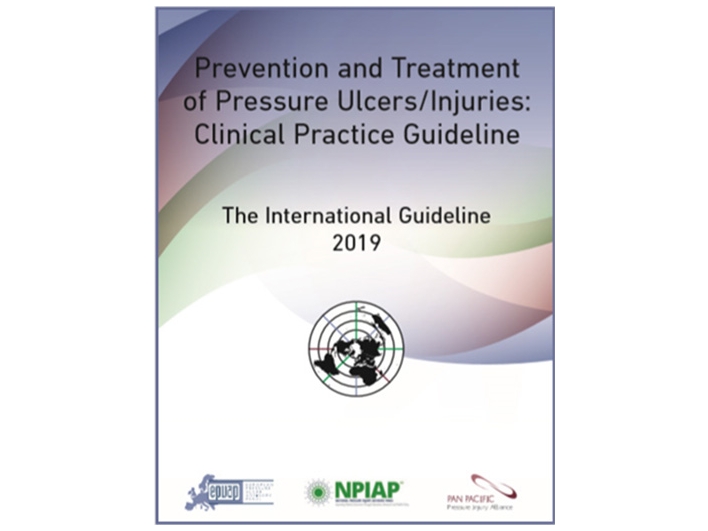Mattress and Bed Support Surfaces for Pressure Ulcer Prevention
Pressure redistributing support surfaces are designed to either increase the body surface area that comes in contact with the support surface (to reduce interface pressure) or to sequentially alter the parts of the body that bear load, thus reducing the duration of loading at any given anatomical site.
1. Use a high specification reactive foam mattress rather than a non high specification reactive foam
mattress for all individuals assessed as being at risk for pressure ulcer development.
(There is no evidence of the superiority of one higher specification foam mattress over any other higher specification foam mattresses.)
1.1. Review the characteristics of foam mattresses used in the facility for pressure ulcer prevention
to ensure they are high specification.
The below table 1 outlines consensus opinion on the minimum characteristics for a product to be considered a high specification foam mattress.
Table 1: consensus on Characteristics that constitute a high specification foam mattress.
|
Characteristic |
Explanation |
High Specification mattress
|
|
Classification |
Classification according to the Australian standards (AS2281-1993) |
Type H/HR H-Conventional resilience, heavy duty. High resilience |
|
Density-Hardness in single layer mattresses |
Density is the weight of the foam in kilograms per cubic meter kg/m3(ponds per cubic foot [PCF] Hardness is the ability of foam to ‘push back’ and carry weight, and is defined as the amount of force(in Newtons) required to indent a sample of the foam by a specific percentage of the original thickness. This is known as the indentation force deflection (IFD). In Australia and Europe hardness is measured at 40% IFD and in US hard ness measured at 25% IFD. Density/hardness defines the grade of foam and is stated with density followed by hardness. |
35 kg/m3(2.18PCF)
130Newtons minimum for single layer foam mattresses.
35-130(density- hardness minimum grade for single lay foam mattress) |
|
Support factor |
Support factor is a component of comfort that is calculated as a ratio: IFD at 65% IFD at 25% = support factor. A higher value usually indicates a softer feel and good base support. |
IFD:1.75 to 2.4. |
|
Depth |
Consider depth of the mattress alongside density/hardness. Different foam grades require different depth to manage a softer feel and good base support. |
150mm(5.9 inches). Mattress depth needs increasing to support bariatric load. |
|
Mattress Cover |
Vapor permeability: the relevant measurement is moisture vapor transmission rate(MVTR). Increasing the MVTR potentially allows the trans-epidermal water loss(TEWL) of intact skin to transpire through the cover. Decreasing he MVR |
MVTR: minimum 300 g/m2/24hrs. (equivalent to normal TEWL) Often 2way stretch
|
|
|
of the cover protects the foam from moisture degradation. Changing the MVTR becomes a compromise between managing local climate conditions and the individual’s TEWL. Allow for partial immersion in foam Wrinkling : may add additional pressure at skin surface Shear resistance: can be reduced with a low friction fabric. Infection control: 。Water proofing-prevents contamination of foam 。welded seam prevent ingress of fluids 。waterfall flap cover over zips 。cleaning according to facility protocol and manufacturers guideline Fire retardant properties: material must meet local standards. |
|
|
Other considerations |
Multi-layering of various grades/types of foam alters the designed features Low resilience /slow recovery/memory foam/viscoelastic: increases the surfaces and allows immersion of bony prominences. Has potential to increase to increase skin surface temperature. Castellated/cross-cut foam: partial thickness cuts made in a regular block pattern on the top of the foam increase surface contact area, potentially reducing friction and shear. Side walls: a border or stiffener along the edge increase firmness and assists mobility and transfers Safety sides(concave shape): may reduce risk of falls but may also reduce bed mobility, need to consider facility restraint policy Hinging system: wedges removed on inner border to allow for folding/bending of mattress to accommodate back rest, upper and lower leg sections to conform to profiling beds. |
Hardness may increase from 130 NEWTONS for the base layer. Hardness may decrease in upper layers and may be less than the minimum standard for a single layer mattress |
1.2. Consider using other reactive support surfaces for individuals assessed as being at risk for pressure ulcer development.
2. Use an active support surface (overlay or mattress) for individuals at higher risk of pressure ulcer development when frequent manual repositioning is not possible.
Selection of an alternating pressure mattress/overlay should consider pressure ulcer risk, comfort of the
individual and effectiveness determined through regular skin assessments.
Referred:
National Pressure Ulcer Advisory Panel (NPUAP)’s Clinical Practice Guideline.

